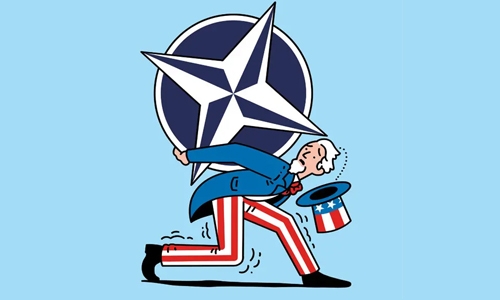What’s the US role in NATO?
NATO, a military alliance, was formed specifically to prevent the Soviet Union from dominating Europe, whose principal powers — Germany, France, Italy and Britain — had been so devastated by World War II that they were vulnerable to Soviet coercion, subversion or conquest. NATO also became a vehicle for rehabilitating the Axis powers — Germany and Italy — under the victors’ tutelage. America had an enduring interest in ensuring that the Continent not fall under the domination of a single, capable, hostile power: That could pose a serious threat to America.
The Truman administration was clear on this point: The main purpose of stationing US military forces in Europe in the early 1950s was to stay long enough to right the balance of power, not to stay forever. By the 1960s, the balance was restored. Western Europe’s economies were booming; Britain and France had become nuclear powers; German militarism had been tamed, even as a new, large modern army emerged in West Germany. During the Vietnam War, America was so free of worry about the Soviet threat that it essentially milked its conventional forces in Europe to support its war in Indochina.
Its European allies contributed nothing to America’s effort in Vietnam. By 1968, with the collapse of Czechoslovakia’s government and army, the Soviet-controlled Warsaw Pact alliance also appeared less capable. In the early 1970s, Sen Mike Mansfield, D-Mont, led an effort to cut the US troop presence in Europe. It lost momentum in part because the Soviet Union conducted an ill-fated military buildup, which contributed to its economic failures in the 1980s. Mansfield’s campaign was also opposed by the Europeans, who preferred to keep their US security blanket, and by President Richard Nixon and his chief foreign affairs adviser, Henry Kissinger, who rejected what he considered congressional meddling in foreign policy.
Oddly, troop reductions in Europe would have been consistent with the “Nixon Doctrine,” which called explicitly for allies to do much more in their own defence. The collapse of the Soviet Union in 1991 removed the last vestiges of a major security threat to NATO, and with it, the rationale for the US military presence in Europe. Russia’s annexation of Crimea and its violent machinations in Eastern Ukraine haven’t improved its ability to threaten NATO. Instead they have placed Putin in the penalty box. The European Union, like America, reacted appropriately by imposing punishing sanctions on Russia. The whole misadventure has diminished Russian power. Europeans are able to defend themselves.
France and Germany together equal Russia’s population, enormously outweigh the country economically and outspend it militarily. But organisations don’t like going out of business, and NATO was a “good brand,” making it useful for other projects. So NATO took on a new goal: banishing security competition from all of Europe and its periphery, and bringing liberal democracy to former subjects of the Soviet empire. Instead of being re-evaluated, NATO got bigger. NATO’s expansion now requires the United States to defend all the new member states from both conventional and nuclear threats — a tall order given their proximity to Russia and a strategically unnecessary project since they can contribute nothing to US national security.
From an organisation that could succeed simply by deterring a major military threat, NATO turned into an expansive project to make all of Western Eurasia safe, liberal and democratic — goals that are much more complicated. NATO’s wars in Bosnia, Kosovo and Libya all depended on significant US military capability; none produced functioning liberal democracies. Among three of post-Cold War NATO’s new members — Hungary, Poland and Bulgaria — democracy is now suffering erosion or is in actual retreat. NATO’s 2008 Bucharest summit declaration that Ukraine and Georgia “will become members of NATO” proved alarming to Russia — and helped pave the way to wars.
In other words, NATO’s well-intended political project is an expensive failure. Ironically, NATO also encourages fecklessness among its members in ways that can be likened to what financiers call the “moral hazard” phenomenon, in which excessive insurance, offered for an ostensibly good purpose, promotes risky behaviour by those insured. America’s wealthy European allies have underfunded their own militaries, secure in the credibility of America’s commitment. Even the most martial European powers, France and Britain, don’t spend enough today to pay for their much-reduced post-Cold War force structures. They barely reach the alliance’s obligation to spend 2 per cent of GDP on defence.
France and Germany spend roughly half, and Britain two-thirds, of what the United States does per soldier; unless they have achieved remarkable levels of efficiency, they must be cutting corners. Germany today spends only about 1.25 per cent of GDP on defence, leaving the German armed forces a sad remnant of their very capable Cold War incarnation. Until 1990, that army could put a dozen heavily armed divisions into the field a few days after mobilisation. Today it would be lucky to get one fully equipped division into the field. Less than half of German military equipment is ready for combat.
While European and US politicians and pundits wring their hands about the Russian military threat, European governments and militaries practice business as usual. The dysfunctional turn in European domestic politics seems to be enabled by elites who fear no foreign threats because the United States dutifully promises to take care of them.
Related Posts

